Periodic Electro-Optical Characteristics of PDLC Film Driven by a Low-Frequency Square Wave Voltage
Abstract
:1. Introduction
2. Experiment and Method
2.1. Materials and Preparation
2.2. Characterization and Measurement
3. Results and Discussion
3.1. PDLC Sample with DC Applied Voltage
3.2. PDLC Sample Applied with an AC Square Wave Voltage
3.2.1. Frequency Range 10–100 mHz
3.2.2. Frequency Range 0.5–2 Hz
3.2.3. Frequency Range 10–50 Hz
- (a)
- In the first T-period
- (b)
- In the second T-period
- (c)
- In the third T-period
- (d)
- In the fourth T-period
3.3. MNPs’ Modulation in the M-PDLC Film
4. Conclusions
Author Contributions
Funding
Institutional Review Board Statement
Informed Consent Statement
Data Availability Statement
Acknowledgments
Conflicts of Interest
Appendix A

Appendix B
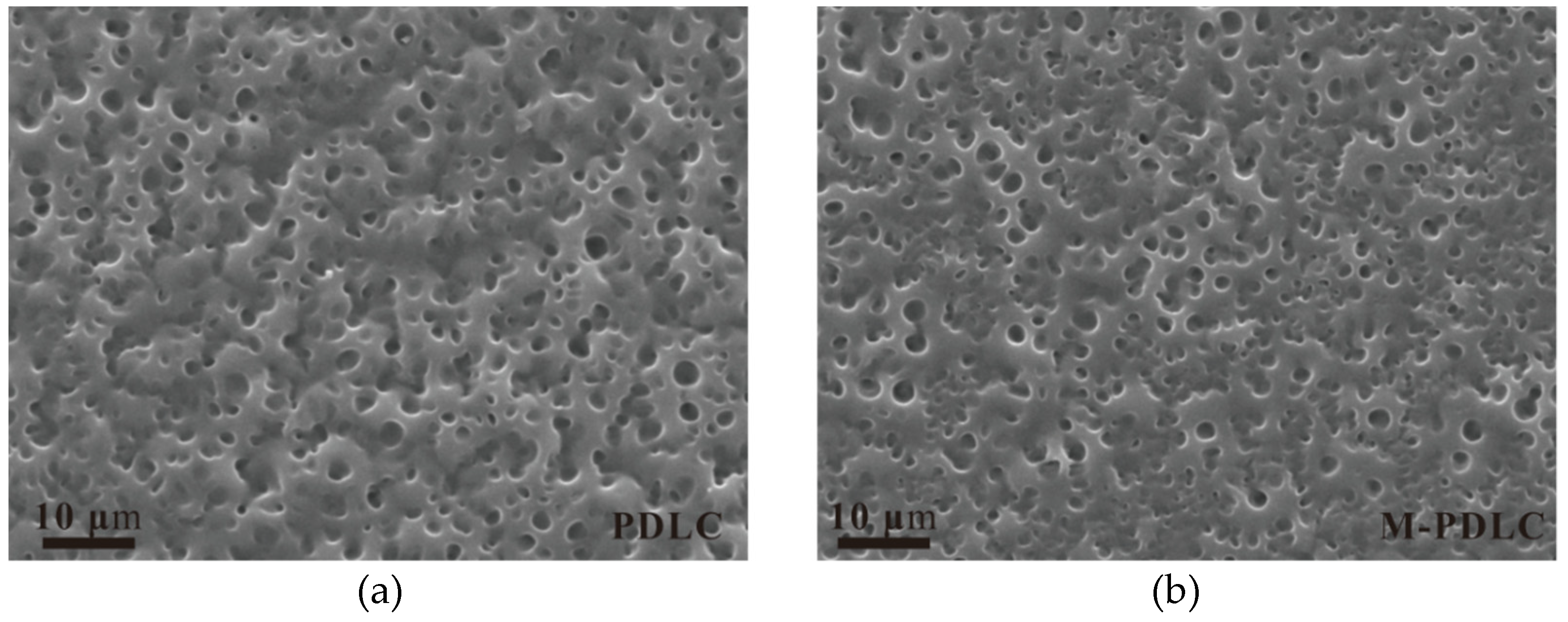
Appendix C

References
- Bouteiller, L.; Barny, P.L. Polymer-dispersed liquid crystals: Preparation, operation and application. Liq. Cryst. 1996, 21, 157–174. [Google Scholar] [CrossRef]
- Singh, S.; Srivastava, J.K.; Singh, R.K. Polymer Dispersed Liquid Crystals. In Liquid Crystalline Polymers; Thakur, V.K., Kessler, M.R., Eds.; Springer International Pubishing: Cham, Switzerland, 2016; pp. 195–250. [Google Scholar]
- Doane, J.W. Polymer Dispersed Liquid Crystal Displays. In Liquid Crystal Application and Uses; Bahadur, B., Ed.; World Scientific: Singapore, 1990; pp. 362–395. [Google Scholar]
- Rumi, M.; Bunning, T.J.; Sio, L.D. Polymer Dispersed Liquid Crystals. In Polymer-Modified Liquid Crystals; Dierjing, I., Ed.; Soft Matter Series; No. 8; The Royal Society of Chemistry: London, UK, 2019; pp. 61–104. [Google Scholar]
- Bloisi, F.; Vicari, L. Polymer-dispersed liquid crystals. In Optical Application of Liquid Crystals; Vicari, L., Ed.; IOP Pubishing Ltd.: Bristol, UK, 2003. [Google Scholar]
- Gardiner, D.J.; Morris, S.M.; Coles, H.J. High-efficiency multistable switchable glazing using smectic A liquid crystals. Sol. Energy Mater. Sol. Cells 2009, 93, 301–306. [Google Scholar] [CrossRef]
- Vaz, N.A.; Smith, G.W.; Montgomery, G.P., Jr. A Light Control Film Composed of Liquid Crystal Droplets Dispersed in a UV-Curable Polymer. Liq. Cryst. 1987, 146, 1–15. [Google Scholar]
- Hassanein, G.N.; Kattan, N.; Ellabban, M.A. Electro-optic properties of aligned and non-aligned polymer dispersed liquid crystals driven by an amplitude-modulated electric signal. Optik 2019, 186, 137–146. [Google Scholar] [CrossRef]
- Wu, B.G.; Erdmann, J.H.; Doane, J.W. Response times and voltages for PDLC light shutters. Liq. Cryst. 1989, 5, 1453–1465. [Google Scholar] [CrossRef]
- Kovalchuk, O.V.; Reshetnyak, V.Y.; Yarmolenko, V.V.; Yaroshchuk, O.V. Low frequency relaxation processes in a PDLC film. Mol. Cryst. Liq. Cryst. 1999, 331, 627–634. [Google Scholar] [CrossRef]
- Liu, H.H.; Lee, W. Time-varying ionic properties of a liquid-crystal cell. Appl. Phys. Lett. 2010, 97, 023510. [Google Scholar] [CrossRef]
- Garbovskiy, Y.; Gluschenko, I. Nano-Objects and Ions in Liquid Crystals: Ion Trapping Effect and Related Phenomena. Crystals 2015, 5, 501–533. [Google Scholar] [CrossRef]
- Garbovskiy, Y. Nanoparticles in Liquid Crystals as Ion-Generating and Ion-Capturing Objects. Crystals 2018, 8, 264. [Google Scholar] [CrossRef] [Green Version]
- Marinov, Y.G.; Hadhichristov, G.B.; Petrov, A.G.; Marino, S.; Versace, C.; Scaramuzza, N. Selective amplitude-frequency electro-optical modulation by polymer-dispersed liquid crystal films aligned by teflon nanolayers. C. R. Acad. Bulg. Sci. 2013, 66, 819–826. [Google Scholar] [CrossRef]
- Costa, M.R.; Altafim, R.A.C.; Mammana, A.P. Ionic impurities in nematic liquid crystal displays. Liq. Cryst. 2001, 28, 1779–1783. [Google Scholar] [CrossRef]
- Meng, X.S.; Li, J.; Lin, Y.Q.; Liu, X.D.; Liu, N.N.; Ye, W.J.; Li, D.C.; He, Z.H. Polymer dispersed liquid crystals doped with low concentration γ-Fe2O3 nanoparticles. Liq. Cryst. 2021, 48, 1791–1805. [Google Scholar] [CrossRef]
- Jain, S.C.; Rout, D.K. Electro-optic response of polymer dispersed liquid crystal films. J. Appl. Phys. 1991, 70, 6988–6992. [Google Scholar] [CrossRef]
- Cupelli, D.; Macchione, M.; Nicoletta, F.P.; de Filpo, G.; Chidichimo, G. Surface anchoring, polarization fields and memory states in polymer dispersed liquid crystals. Liq. Cryst. 2001, 28, 287–290. [Google Scholar] [CrossRef]
- Drzai, P.S. Liquid Crystal Dispersions; World Scientific: Singapore, 1995; pp. 236–291. [Google Scholar]
- Maschke, U.; Coqueret, X.; Benmouna, M. Electro-optical properties of Polymer-Dispersed Liquid Crystals. Macromol. Rapid Commun. 2002, 23, 159–170. [Google Scholar] [CrossRef]
- Cupelli, D.; Nicoletta, F.P.; de Filpo, G.; Cassano, R.; Puoci, F.; Chidichimo, G. The electro-optical properties of ‘charged’ PDLCs. Liq. Cryst. 2005, 32, 395–400. [Google Scholar] [CrossRef]
- Kelly, J.R.; Seekola, D.L. Dielectric losses in a polymer-dispersed liquid crystal film. SPIE 1990, 1257, 17–28. [Google Scholar]
- de Filpo, G.; Huang, Z.; Chidichimo, G.; Imbardelli, D. Measurement of the polarization field in PDLC with memory state. Mol. Cryst. Liq. Cryst. 1997, 304, 71–79. [Google Scholar] [CrossRef]
- Meng, X.S.; He, Z.H.; Zhao, J.W.; Lin, Y.Q.; Liu, X.D.; Li, D.C.; Li, J.; Qiu, X.Y. Oleic acid surface modification in the preparation of magnetic nanoparticles by a chemically induced transition. IEEE Tran. Magn. 2018, 54, 2300107. [Google Scholar] [CrossRef]

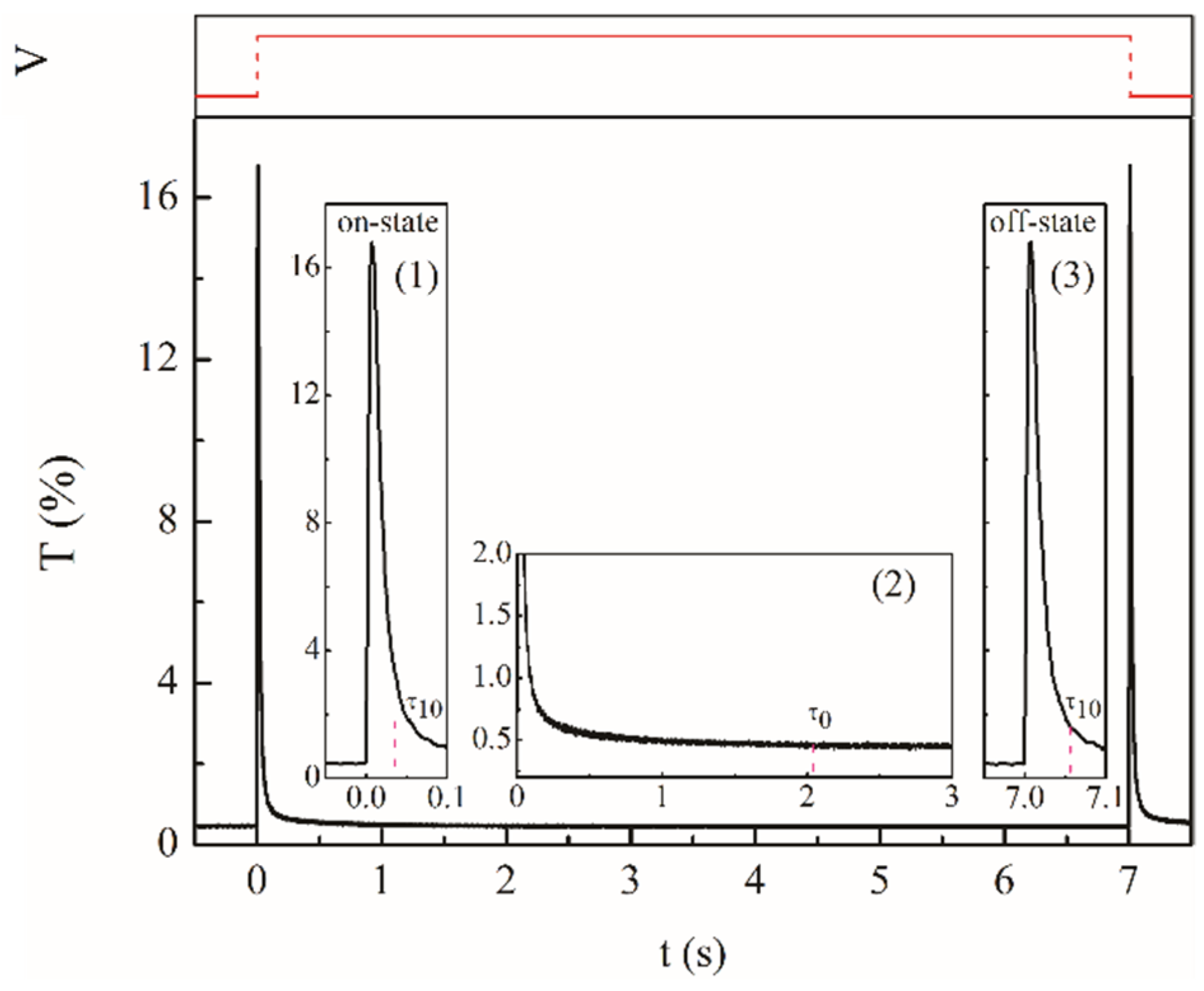

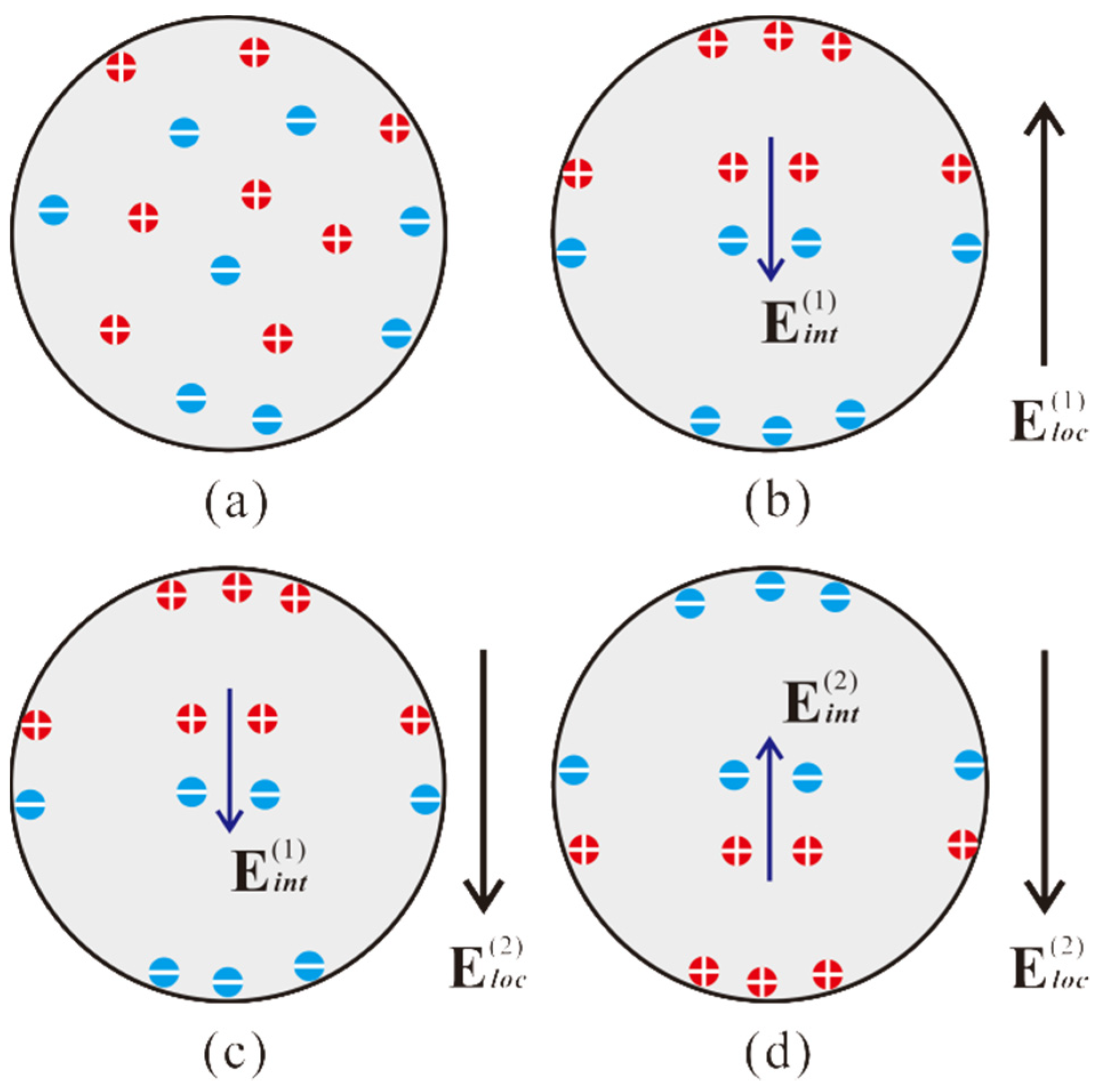
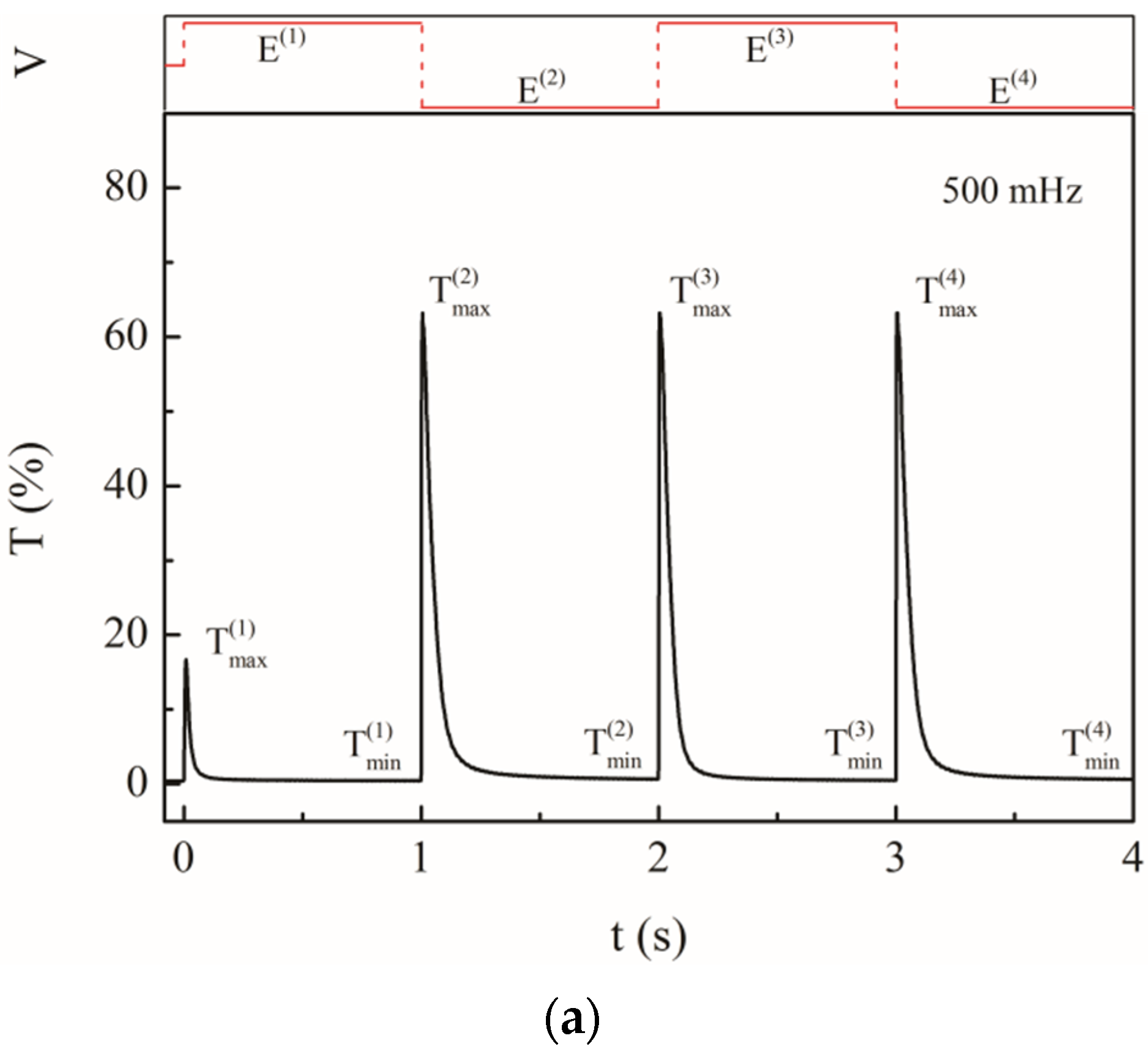

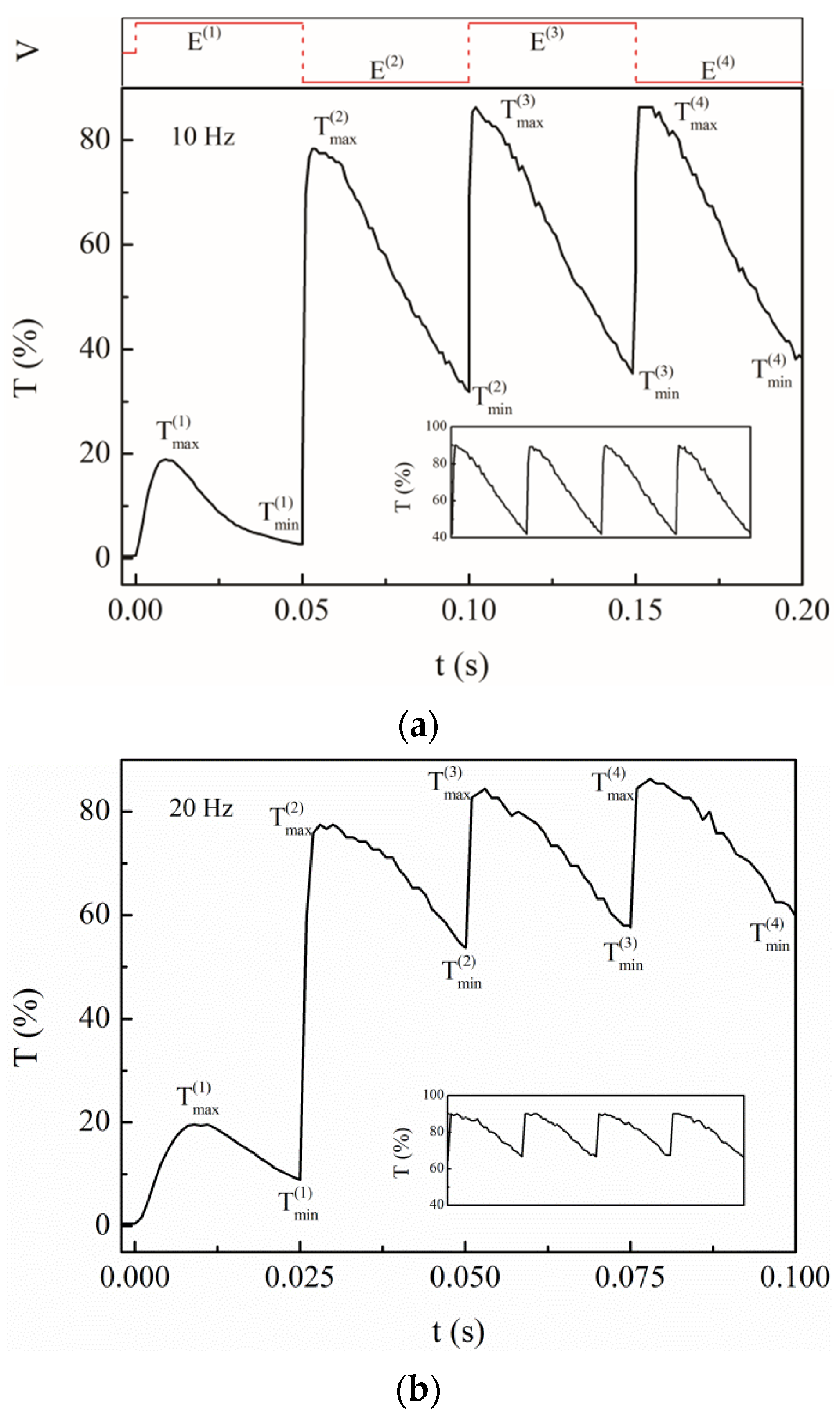

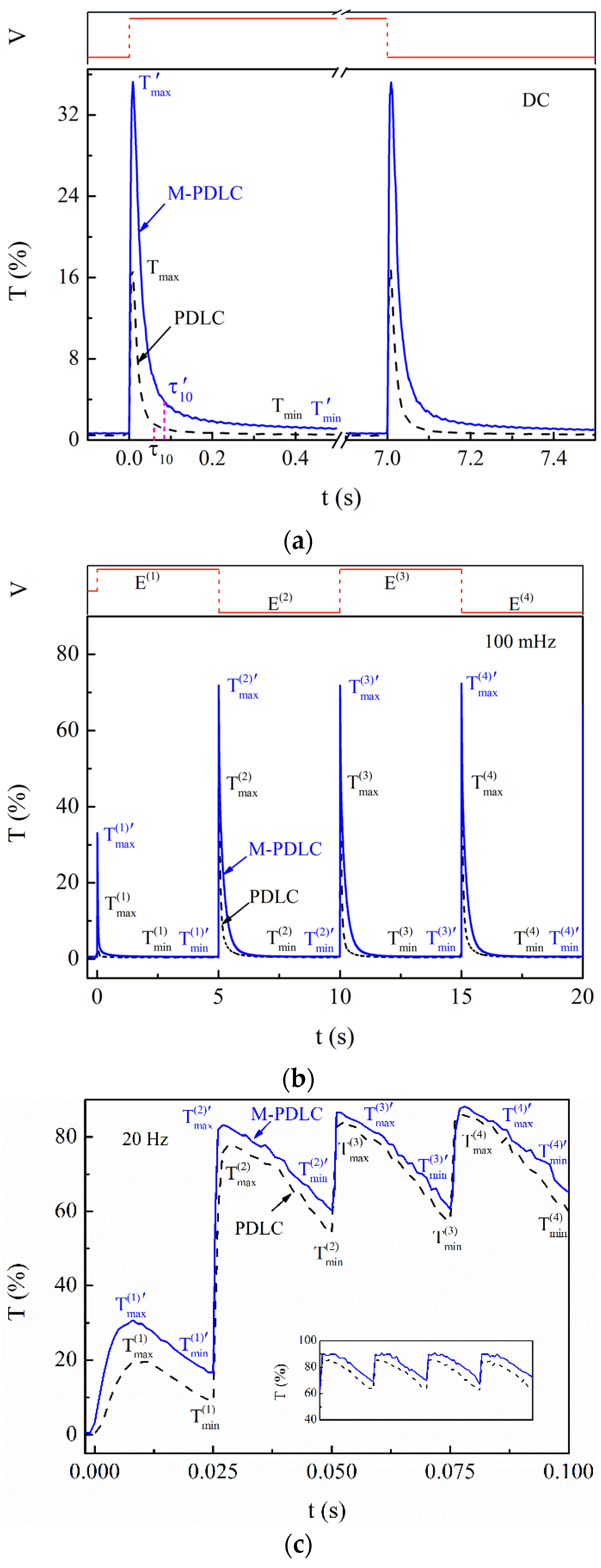
| DC | 10 mHz | 20 mHz | 100 mHz | |
|---|---|---|---|---|
| 16.81 | 17.21 | 17.21 | 17.21 | |
| 0.41 | 0.42 | 0.42 | 0.44 | |
| 0.024 | 0.024 | 0.024 | 0.026 | |
| (ms) | 56 | 57 | 57 | 59 |
| 65.24 | 64.54 | 64.54 | ||
| 0.42 | 0.42 | 0.44 | ||
| (×10−1) | 0.064 | 0.065 | 0.068 | |
| (ms) | 201 | 205 | 202 | |
| 3.79 | 3.75 | 3.75 |
| 10 Hz | 20 Hz | 50 Hz | |
|---|---|---|---|
| 18.96 | 19.58 | 20.44 | |
| 2.82 | 8.92 | 19.53 | |
| 0.149 | 0.455 | 0.955 | |
| 78.32 | 77.48 | 72.64 | |
| 35.69 | 53.78 | 68.20 | |
| 0.456 | 0.695 | 0.939 | |
| 4.131 | 3.957 | 3.554 |
Publisher’s Note: MDPI stays neutral with regard to jurisdictional claims in published maps and institutional affiliations. |
© 2022 by the authors. Licensee MDPI, Basel, Switzerland. This article is an open access article distributed under the terms and conditions of the Creative Commons Attribution (CC BY) license (https://creativecommons.org/licenses/by/4.0/).
Share and Cite
Meng, X.; Li, J.; Lin, Y.; Liu, X.; Zhao, J.; Li, D.; He, Z. Periodic Electro-Optical Characteristics of PDLC Film Driven by a Low-Frequency Square Wave Voltage. Crystals 2022, 12, 163. https://doi.org/10.3390/cryst12020163
Meng X, Li J, Lin Y, Liu X, Zhao J, Li D, He Z. Periodic Electro-Optical Characteristics of PDLC Film Driven by a Low-Frequency Square Wave Voltage. Crystals. 2022; 12(2):163. https://doi.org/10.3390/cryst12020163
Chicago/Turabian StyleMeng, Xiangshen, Jian Li, Yueqiang Lin, Xiaodong Liu, Jianwei Zhao, Decai Li, and Zhenghong He. 2022. "Periodic Electro-Optical Characteristics of PDLC Film Driven by a Low-Frequency Square Wave Voltage" Crystals 12, no. 2: 163. https://doi.org/10.3390/cryst12020163
APA StyleMeng, X., Li, J., Lin, Y., Liu, X., Zhao, J., Li, D., & He, Z. (2022). Periodic Electro-Optical Characteristics of PDLC Film Driven by a Low-Frequency Square Wave Voltage. Crystals, 12(2), 163. https://doi.org/10.3390/cryst12020163







